Vodka - A Passion for Purity
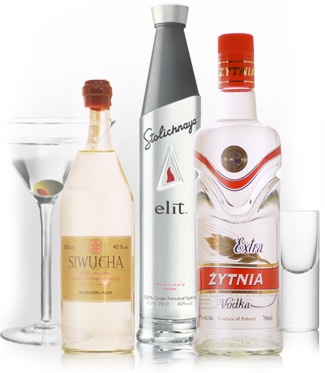 Vodka:
Vodka:
A Passion for Purity.
"The Church is near but the road is icy.
The Tavern is far but I will walk carefully".
- Russian Proverb
Of all the world's spirits, vodka is the most basic. Unaged, colourless, and almost completely absent of aroma or taste. In spite of our innate desire for variety, for centuries it has been the spirit of Eastern Europe, born from the long freezing winters when sometime around the eighth century, a bottle of strong wine, mead or beer was probably left outside, thus freezing off the water to leave a residue of raw alcohol. The separated alcohol was at first mixed with herbs, and prescribed as a medicine, rather than a drink, a practice which continued until the introduction of distilling into Eastern Europe in around 1400's.
In a region of the world where long winters and short cultivation and growing seasons meant that nearly all the most intense labour, (up to sixteen hours per day) occurred between June and August, the fact that vodka could be distilled from virtually any type of agricultural produce, coupled with its unique ability to accompany whatever food was available, made vodka a natural and even inevitable development of Eastern European peasant culture.
However, there remains ongoing disagreement amongst Russians, Poles and Swedes as to which country was the first to distill vodka. Most historical references credit Russia; alternative accounts only reinforce the uncertainty of the matter. Whichever country it happened in first, the word Vodka (from the Russian word'voda',meaning water) was originally used to describe grain distillates that were used for medicinal purposes. As distilling techniques improved Vodka ('Wodka' in Polish) gradually came to be the accepted term for beverage spirit, regardless of its origin.
Today, vodka continues to be made from the cheapest starch-rich agricultural produce - grain, corn, potatoes, barley, soybeans or raw materials containing sugar such as grapes, molasses and sugar beets. However, vodka is not limited to these and can actually be made from a diverse variety of other natural products such as fruit, milk, whey or honey. The question as to what ingredient makes the best vodka remains the subject of much debate. Yet given that many of the common vodka ingredients form the basis for other classic spirits, (Whisky, Rum, Gin and Brandy)what makes vodka unique?
There are actually several points of difference, all of which involve the manner in which vodka is produced.
Making Vodka
All vodkas begin with grain or vegetable ingredient in a mash tub fitted with agitators that break down the ingredients as the tub rotates. If using starch based ingredients, such as potatoes or corn, the first step is to gelatinize the starch - that is, heat it until it forms a paste. Saccharification follows whereby ground malt meal is added to promote the conversion of starches into maltose (a kind of sugar). To prevent the growth of bacteria, the mash is sterilized by boiling, then cooled and poured into large stainless-steel vats. Yeast is added and the vats are closed. Over the next two to four days, enzymes in the yeast convert the sugars in the mash into ethyl alcohol to produce a "wash". But when the wash gets much beyond 15% alcohol, the yeasts cannot survive and their work stops. In order to produce vodka, it is necessary to distill.
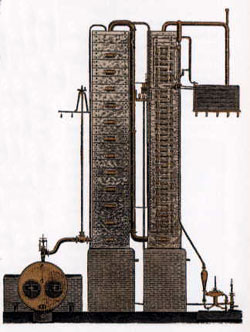 |
| Above: An Early Column Still. |
Distillation
Distillation is essentially the separating of the more volatile component, alcohol, from the less volatile component, water, by heating the wash and then condensing and collecting the alcohol rich vapours as they are released. It is not unusual for some vodkas to be distilled three or four times (and more), with each re-condensation from the previous vapour-state achieving a higher alcohol concentration.
Traditionally, all vodka was made using a Pot Still in a slow, single batch process. Resembling a copper pot, the pot still is bulbous at the base and narrows to a goose-neck at the top. Heated from below, vapours from the low strength wash pass up through the gooseneck then down through a condenser where they reform into a liquid and are collected. The Pot Still method retains more flavour from the wash, which could be considered a good or a bad thing, depending on the style of vodka you are intending to produce. But since the 1830's, the Pot still gradually lost favour amongst Vodka producers to to a new invention, the Column Still (also known as the Continuous Still or Coffey Still) a method by which virtually all vodkas are produced today. There are exceptions, such as Holland's 'Ketel One' distillery, yet even they employ a pot still only for a final 'polishing' distillation.
The Continuous Still does what its name implies: The low strength wash enters the still in a continuous stream, is heated and then flows down a series of perforated copper plates in a column, up through which steam is rising. The steam collects the alcohol in ever increasing quantities until it is drawn off, passed through a condenser to be finally collected in a receiver. This performs many distillations in a single process allowing large batches of high proof alcohol to be produced continuously and efficiently.
The product of the initial distillation, known as 'low wine' or 'moonshine', contains two types of alcohol: 'Ethanol' which makes us feel euphoric or drunk, and 'methanol', which not only tastes terrible but is toxic in even moderate doses. Other impure and foul smelling chemicals include fusel oils, butyl alcohol, isoamyl alcohol and aldehydes. Collectively known as 'congeners', these impart a fiery mouthfeel to the spirit. To create vodka with sufficient alcohol that is also fit for consumption, firstly, the methanol content must be reduced to no more than 0.5g per litre of alcohol. Secondly, unlike other spirits such as Whisky which actually rely on small amounts of congeners to contribute flavour, in vodka, all such 'impurities' are removed. In fact, most vodkas will contain around thirty milligrams of congeners per litre, as opposed to Whiskies and Cognacs which might contain up to twenty six hundred.(1) Consequently, Vodka's concentration and purification, via a process known as 'rectification', also removes the flavours characteristic of the base ingredient.
Rectification by re-distillation continues until a water/alcohol solution of 95.6% Alc./Vol. is achieved, at which stage the water and the alcohol have the same volatility. No more concentration of the alcohol is possible using standard distillation techniques. Distillers refer to the resulting liquid as "Neutral Grain Spirit" (a.k.a. NGS or NGA). And it is from this spirit that all vodkas are born.
Because of the relative neutrality and sameness of NGS, few vodka rectifiers or bottlers need bother to distill their own. In fact, most of the world's most famous vodkas are not made by the brand owner, but rather purchased from a bulk NGS producer and then marketed. (In the U.S. for example, there are four distillers who produce about 99% of the NGS that is used to make vodka domestically, while in Finland, Germany and Sweden, the government actually owns the distilling process and produces all of the NGS used to make vodka in those countries).
The aim of the end vodka rectifier, bottler or marketer is to remove even the minute traces of remaining fusel oils, aldehydes, esters, acids, and solids from the NGS in order to obtain the cleanest flavour possible. Rather than a question of stylistic preference, this is actually a requirement in some countries. U.S. and European law, for example, demands that "...Vodka is to be without distinctive character, aroma, taste, or color".(2)In other parts of the world, standards for making vodka vary. And in the traditional vodka producing nations of Eastern Europe, for example, many distillers actually prefer to preserve flavours and characteristics which make their products unique.
Filtration
When complete neutrality is required, it is generally achieved via filtration - a process which remains the best and simplest adjunct to the rectifier. Early European producers initially carried out filtration with coagulants like egg whites (in the same way winemakers use them today), then later felt cloth, paper or river sand were used. In the late eighteenth century, experiments with charcoal began and it was found to be particularly effective for removing oily contaminants. It has remained the filter of preference to this day. Before vodka is filtered, it is usually blended with demineralised water, reducing it to about 55% Alc./Vol. The vodka is then pumped through several consecutive columns of charcoal or, in the case of cheaper vodkas, simply seeped into charcoal filled tanks. Each brand's filtration process remains a trade secret and is manipulated as a marketing device. Smirnoff, for example, proudly proclaim that each drop of their vodka passes through seven tons of activated charcoal (charcoal which has been treated either by steam or chemicals to make it more absorbent). Poland's Luksusowa uses charcoal and oak chips. Finland's Finlandia prefers Glacial rock, while others employ quartz crystals or limestone.
This fetish for filtration is not universal. In fact, one of the largest and most famous Vodka brands in the world, Sweden's 'Absolut', defers from it altogether."Charcoal is for barbecues"one of Absolut's directors was quoted as saying."We rely on our distinctive distillation methods to produce a pure product that still bears character."(3) Australia's own Ben Anderson who produces Vodka 'O' has a similar take on filtration:"Consumers are under the misconception that the more times you filter the Vodka the more pure it is"he says."This is simply untrue as it's a scale of diminishing returns in that the vodka undergoes 90% of its maximum clean the first time it passes through the filter. Furthermore filters are very expensive so financially it would be economic suicide to keep filtering Vodka for additional improvement." Instead, Anderson refines his Vodka using heat."...Alcohol molecules are very close together and heating is the best way to separate the high quality pure alcohol from the rubbish. This whole process is repeated seven times".Anderson's unique evaporative technique reduces his vodka to only five parts per million of methanol. The result reputedly contains the lowest impurity levels of any Vodka currently on the market.
Water
The addition of water marks the final step in the production process, cutting back the spirit to each country's legal minimum strengths - usually around 37% - though it is not unusual to see vodkas around 50% Alc./Vol. Water is a contentious issue for many vodka aficionados, and perhaps justifiably so. "If you start with something that is 95% alcohol"explains Robert Hess,"and you want to reduce that percentage down to 40% (80 proof), how much water would you need to add? By my calculations it turns out to around 58%, thus making your vodka 60% water. This would result in making the water you add to your vodka the most important component from a flavour perspective". (4) Not surprisingly, like filtration, vodka marketers play up the significance and superior quality of the various waters they use - from pure spring water, to water which has cascaded over porous limestone, to water sourced from ancient, pristine Arctic glaciers or from artesian wells created during the Oligocene epoch. Brand ambassador for Grey Goose insists "It's not a con job...we have a master blender, we use artesian water ... these are key factors that make it taste better". (5)
Vodka does not legally require anything else added to it after water, although some producers include additives to improve one or another characteristic. Others introduce flavouring by either adding natural essences or by steeping fruits, herbs or spices in the vodka for several days. Whatever the case, unlike nearly all other spirits, vodka is ready for immediate consumption. Except for a few minor styles, Vodka is never put in wooden casks or aged for any extended period of time.
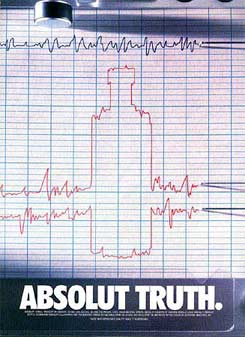 |
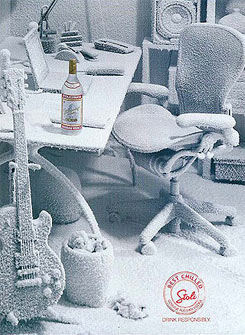 |
 |
Vodka Styles & Regions (6)
Every Eastern European country produces Vodka, and most also have local flavoured specialties. Russia, Ukraine and Belarus produce the full range of Vodka types, and are generally acknowledged to be the leaders in Vodka production. Only the better brands, all of which are distilled from rye and wheat, are exported to the West. Poland produces and exports both grain- and potato based Vodkas. Most of the high quality brands are produced in pot stills. Finland, along with the Baltic States of Estonia, Latvia, and Lithuania, produce primarily grain-based Vodkas, mostly from wheat. Sweden has, in recent decades, developed a substantial export market for its straight and flavored wheat-based Vodkas. The United States and Canada produce non-flavoured Vodkas, both from various grains (including corn) and from molasses. The Caribbean produces a surprising amount of Vodka, all of it from molasses. Most of it is exported for blending and bottling in other countries.
There are no uniform classifications of Vodka. In Poland, Vodkas are graded according to their degree of purity: standard (zwykly), premium (wyborowy) and deluxe (luksusowy). In Russia Vodka that is labeled osobaya (special) usually is a superior-quality product that can be exported, while krepkaya (strong) denotes an overproof Vodka of at least 56% ABV.
 |
| Grey Goose Vodka, one of the more successful recent brands not produced in traditional vodka country, but rather from Cognac, France. |
Rye and wheat are the classic grains for Vodka, with most of the best Russian Vodkas being made from wheat while in Poland they are mostly made from a rye mash. Swedish and Baltic distillers are partial to wheat mashes. Potatoes are looked down on by Russian distillers, but are held in high esteem by some of their Polish counterparts. Molasses, a sticky, sweet residue from sugar production, is widely used for inexpensive, mass-produced brands of Vodka. American distillers use the full range of base ingredients.
Flavored Vodkas have been produced from the start, originally to mask the flavor of the first primitive Vodkas, but later as a mark of the distiller's skill. The Russians and Poles in particular still market dozens of flavors. Some of the better known types are:
Kubanskaya- Vodka flavored with an infusion of dried lemon and orange peels.
Limonnaya- Lemon-flavored Vodka, usually with a touch of sugar added.
Okhotnichya-"Hunter's" Vodka is flavored with a mix of ginger, cloves, lemon peel, coffee, anise and other herbs and spices. It is then blended with sugar and a touch of a wine similar to white port. A most unusual Vodka.
Pertsovka- Pepper-flavored Vodka, made with both black peppercorns and red chili peppers.
Starka - "Old" Vodka, a holdover from the early centuries of Vodka production, which can be infused with everything from fruit tree leaves to brandy, Port, Malaga wine, and dried fruit. Some brands are aged in oak casks.
Zubrovka- Zubrowka in Polish; Vodka flavored with buffalo (or more properly "bison") grass, an aromatic grass favored by the herds of the rare European bison.(6)
Do all Vodkas Taste the Same?
Ingrained into the very nature of vodka is a conundrum that has created the need for big vodka brands to constantly reinforce image and promotion: As most vodkas are inherently light on aroma and flavour (differentials which distinguish other spirits like whiskies, gins or rums for example), there is simply little else to sell on other than the origin of the base ingredients and the vodka's 'purity'. This may well be why many drinkers feel that the only real way of differentiating between brands is by alcohol content and price. Yet as we have mentioned, vodka can be distilled and rectified in many ways and from a great many substances. (The Russian oil conglomerate 'Yukos' recently made headlines marketing a vodka distilled from hemp seeds). If it were true that all vodkas tasted alike, there'd be no reason to favour a $70 bottle over a $25 bottle. Each brand has a unique, though subtle, aroma, taste and burn (i.e., the hot sensation the spirit creates as you swallow it). In fact, depending on the source ingredient, vodka's flavours can be remarkably diverse. Some enthusiasts believe that the popular grain-based vodkas, for example, tend to be smoother and can even taste subtly fruity, while vegetable-based vodkas are often harsh or even slightly medicinal.
Wheat, dough, pastry, cream, vanilla, talc, mineral water, icing sugar, marsh mellow, confectionary, citrus, dried fruits, spice and pepper are amongst some of the more common aromas of vodka. These notes may follow onto the palate, however variations in mouth feel and perceived temperature rather than actual tastes are more readily discernible. Vodka's alcohol can issue a sensation of 'false heat' in the same way spicy foods do, while its textures can range from full, medium to light bodied, to oily, glycerous, silky, creamy or coarse, to clean, water-like or drying sensations and even oral pain and prickle sensations.
The price of a vodka does not necessarily reflect its quality, which ultimately lies in the type of raw materials being used, the distillation technique and the quality of the bottling. Marketing costs often exceed production costs many times over, so that less expensive brands that bypass extravagant presentation can offer excellent value. At the same time, many inexpensive, mass produced brands might be fine for mixed drinks, but not to drink straight. Conversely, top-shelf brands such as Grey Goose are too good (and too expensive) to mix with anything but ice, or as some prefer, straight from the freezer or from a warm glass. As a general rule, higher proof vodkas tend to bring out the flavour of what they are being mixed with, so are more appropriate for the thousands of cocktails of which vodka is a key element.
For value for money and everyday drinking and mixing, we recommend Vodka 'O',Finlandia or Wyborowa.
But if you're looking for something special to enjoy neat, try 42 Below,,Rain or Grey Goose.
 "It's not to late...stop!" |
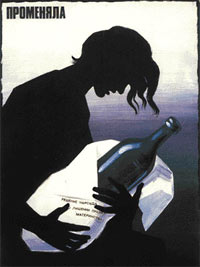 "Bartered"
|
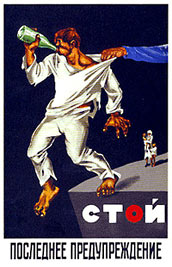 "STOP! - Last Warning." |
Vodka Today
Despite its late entry into Western markets during the 1930's, Vodka has achieved a phenomenal following. By the mid-1960's in the U.S. at least, vodka was already outselling Gin. By 1976 it outsold whiskey, and by the end of the decade, a martini was more likely to be made with vodka than with its original ingredient, Gin. Today, vodka has come full circle from its rustic beginnings. It is now the world's most popular alcoholic drink with global sales reaching almost US $48.5 billion in 2006.(7)While Eastern Europe remains the dominant market (approx. 70%), helped along by its versatility as a mixer and some sophisticated advertising campaigns, premium and super premium vodkas continue to see growth in the West alongside an ever increasing selection of flavoured styles. Many in the industry believe the market has reached saturation point, in terms of brands and variety. But this has not stopped ongoing innovation, with every possible niche being targeted. It would seem that the sheer enormity of the global vodka market will ensure an arena of new and exciting creations for some time to come.

Classic Vodka Cocktails...
The Bloody Mary
This is one of the few cocktails traditionally served in the morning, along with the Screwdriver. The name Bloody Mary is used to refer to the blood-like colour of the cocktail, but may have also been derived from "Bloody" Mary Tudor, Queen of England.

The order of preparation can be crucial, and many bartenders guard secret recipes for the drink. Fernand Petiot claims to have created the Bloody Mary as we know it today and describes in The New Yorker, 18 July 1964, the manner in which he made it: "George Jessel said he created it", says Fernand, "but it was really nothing but vodka and tomato juice when I took it over. I cover the bottom of the shaker with four large dashes of salt, two dashes of black pepper, two dashes of cayenne pepper, and a layer of Worcestershire sauce; I then add a dash of lemon juice and some cracked ice, put in two ounces of vodka and two ounces of thick tomato juice, shake, strain, and pour. We serve a hundred to a hundred and fifty Bloody Marys a day here in the King Cole Room and in the other restaurants and the banquet rooms."
- 60ml Vodka
- a few dashes of worcestershire sauce
- a few dashes of tabasco (to taste)
- salt
- lemon
- tomato juice
Method: Stir or shake the vodka with the sauces and the spices. Fill up with tomato juice in a highball glass with ice. Garnish with a celery stick, if you like it and want to add some vitamins. If you don't have any fresh celery at home add celery salt.
- notes partially sourced from www.drinkboy.com
The Screwdriver

One of the earliest references to the Screwdriver is from the October 24, 1949 issue of Time Magazine: "In the dimly lighted bar of the sleek Park Hotel, Turkish intelligence agents mingle with American engineers and Balkan refugees, drinking the latest Yankee concoction of vodka and orange juice, called a "screwdriver." Another story claims that, "...the screwdriver, which tastes like orange juice but is considerably more potent, is believed to have originated with American oil workers in Iran who drank vodka and orange juice, stirring it with screwdrivers they carried attached to their fatigue pants by loops."
|
The Harvey Wallbanger
A Californian surfer named Harvey, bought Galliano to 'club prominence' when, after losing an important surfing competition, drank too much of his favourite drink - a screwdriver with added Galliano. He left the bar bouncing off the walls, and the "Harvey Wallbanger" was born.
50ml Vodka
A small float of Galliano Original
10 ml Orange juice
Method: In a tall glass generously filled with ice, add vodka and orange juice. Stir Well. Float the Galliano on top. Garnish with an orange slice. Serve with straws.


1. Gordon Brown, Classic Spirits of the World. A Comprehensive Guide. Prion Books Ltd, 1995
2. US law states that: "(a) "Neutral spirits" or "alcohol" are distilled spirits produced from any material at or above 190[deg] proof, and, if bottled, bottled at not less than 80[deg] proof. (1) "Vodka" is neutral spirits so distilled, or so treated after distillation with charcoal or other materials, as to be without distinctive character, aroma, taste, or color".
3. What's the difference between vodka and water? Wine & Spirit Magazine, Graham Holter Feb 2008.
4. Distilled Water, With A Kick, By Robert Hess www.drinkboy.com
5. What's the difference between vodka and water? Wine & Spirit Magazine, Graham Holter Feb 2008.
6. Vodka regions adapted from www.tastings.com
7. Drinks International Magazine Special Vodka Report Edition March 2007
